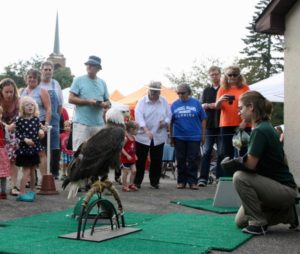A trip to the farmers market usually doesn’t include a chance to meet birds of prey, but on Aug. 2, visitors to the Nokomis Wednesday Farmers Market could come and see, up close, three Minnesota raptors. The birds, an 18-year-old bald eagle, a 2-year-old red-tailed hawk and a 3-year-old American kestrel falcon, from the University of Minnesota Raptor Center, showed up accompanied by naturalists Kelsey Jennings and Anna Voss.
The Raptor Center finds injured birds—around 800 every year—and works to nurse them back to health, usually releasing them into the wild. But, some birds have permanent injuries and they, said Jennings, get jobs as teachers at the Center, traveling to dozens of events, like the Farmers Market.
“These birds wouldn’t survive in the wild,” said Voss. Maxime, the bald eagle, came into the center at age 1 after having flown into a power line. Rowan, the hawk, was born with microphthalmia, where one eye is smaller than the other, making the bird unable to hunt. Sienna, the falcon, is missing part of a wing.
The American kestrel is the smallest of the three, at a quarter pound. The hawk weighed in at 2 pounds. By far the largest, and getting the most attention from the crowd, was the bald eagle.
At about 11 pounds, in the wild they can carry off a 5-pound prey fish, one of their favorite foods. “But, they aren’t very successful hunters,” Jennings said. “They eat a lot of road-kill and especially like gut piles.”
The birds undergo years of training, making them calm around people. They learn to stay on perches, rewarded for calm behavior with pieces of raw meat. People, even little kids, can get within a few feet of the birds while the naturalists answer questions. And while they are well trained, at public events, all the birds wear leashes attached to their talons, just in case they get frightened. “We wouldn’t want them to fly away and get hit by a car,” said Voss.
It takes a lot to startle these birds. In the middle of the two-hour event, there was a medical emergency. An ambulance, lights blazing and siren blasting, came within a few feet of the exhibit area. Jennings and Voss fed meat to the birds to distract them. The birds barely reacted, staying calm. “These birds are pros at their job,” Jennings said.
The birds, she said, all have vastly different temperaments. “I never knew that wild birds would have such different personalities. Some are sassy, some are fun. They are all food motivated, but some are picky eaters and will throw their food if they don’t like it. Some will spread their wings and stomp on our gloves.”
During the year, the birds go to public events all over the Twin Cities, including at places such as senior centers, day cares and schools. “The kids love it,” said Voss.
It wasn’t just kids who came to see the birds. Robin Berry, who used to work education programs at the Raptor Center and lives nearby, is a bird artist. She thinks that events like this are important, a way to educate young and old alike. “It’s a chance to get up close to the raptors, something most people don’t get to do every day.”
The Nokomis Raptor event was sponsored by nearby Minnehaha Animal Hospital.























